Temporal Evolution of Pressure Generated by a Nanosecond Laser Pulse Used for Assessment of Adhesive Strength of the Tungsten–Zirconium–Borides Coatings
Abstract
:1. Introduction
2. Materials and Methods
2.1. Materials and Coatings
2.2. Shock Wave Pressure
2.3. Theoretical Model
3. Results and Discussion
3.1. Theoretical Surface Pressure
3.2. Experimental Measurement of Pressure
3.3. Coating Adhesion Test
4. Conclusions
- The amplitude of the shock wave estimated based on the proposed hydrodynamic model was validated experimentally. Both methods showed good agreement. The maximal pressure in water near the sample surface can reach 2 GPa. Time duration of the first pressure peak is about 50 ns;
- Based on knowledge of shock wave pressure and acoustic impedance of tested materials, adhesive strength of coatings can be determined. The estimated amplitude of the tensile wave that caused W–Zr–B film delamination was about 320 MPa;
- The described above method is simple and does not require advanced equipment. The proposed method is less time-consuming than a traditional scratch test, which additionally needs greater surface to measure. However, the thickness of the sample is a limiting factor in the measuring range.
Author Contributions
Funding
Institutional Review Board Statement
Informed Consent Statement
Data Availability Statement
Conflicts of Interest
References
- Askaryon, G.A.; Moroz, E.M. Pressure on evaporation of matter in a radiation beam. JETP Lett. 1963, 16, 1638–1644. [Google Scholar]
- Gregg, D.W.; Thomas, S.J. Momentum transfer produced by focused laser giant pulses. J. Appl. Phys. 1966, 37, 2787–2789. [Google Scholar] [CrossRef]
- Anderholm, N.C. Laser generated stress waves. Appl. Phys. Lett. 1970, 16, 113–115. [Google Scholar] [CrossRef]
- Skeen, C.H.; York, C.M. Laser-Induced “blow-off” phenomenon. Appl. Phys. Lett. 1968, 12, 369–371. [Google Scholar] [CrossRef]
- O’Keefe, J.O.; Skeen, C.H.; York, C.M. Laser Induced Deformation Modes in Thin Metal Targets. J. Appl. Phys. 1973, 44, 4622. [Google Scholar] [CrossRef]
- Yang, L.C. Stress waves generated in thin metallic films by a Q-switched ruby laser. J. Appl. Phys. 1974, 45, 2601–2608. [Google Scholar] [CrossRef]
- Fairand, B.P.; Clauer, A.H.; Jung, R.G.; Wilcox, B.A. Quantitative assessment of laser-induced stress waves generated at confined surfaces. Appl. Phys. Lett. 1974, 25, 431–433. [Google Scholar] [CrossRef]
- Fairand, B.P.; Clauer, A.H. Effect of water and paint coatings on the magnitude of laser-generated shocks. Opt. Commun. 1976, 18, 588–591. [Google Scholar] [CrossRef]
- Fairand, B.P.; Clauer, A.H. Laser generation of high-amplitude stress waves in materials. J. Appl. Phys. 1979, 50, 1497–1502. [Google Scholar] [CrossRef] [Green Version]
- Fairand, B.P.; Wilcox, B.A.; Gallagher, W.J.; Williams, D.N. Laser shock-induced microstructural and mechanical property changes in 7075 aluminum. J. Appl. Phys. 1972, 43, 3893–3895. [Google Scholar] [CrossRef]
- Montross, C.; Wei, T.; Ye, L.; Clark, G.; Mai, Y. Laser shock processing and its effects on microstructure and properties of metal alloys: A review. Int. J. Fatigue 2002, 10, 1021–1036. [Google Scholar] [CrossRef]
- Clauer, A.H.; Holbrook, J.H. Effects of Laser Induced Shock Waves on Metals. In Shock Waves and High-Strain-Rate Phenomena in Mtals; Meyers, M.A., Murr, L.E., Eds.; Plenum Publishing Corporation: New York, NY, USA, 1981; pp. 675–703. [Google Scholar]
- Mocko, W.; Radziejewska, J.; Sarzyński, A.; Strzelec, M.; Marczak, J.; Rycyk, A. Analysis of the plastic deformation of AISI 304 steel induced by nanosecond laser pulse. Opt. Laser Technol. 2017, 90, 165–173. [Google Scholar] [CrossRef]
- Radziejewska, J. Application of a nanosecond laser pulse to evaluate dynamic hardness under ultra-high strain rate. Opt. Laser Technol. 2016, 78, 125–133. [Google Scholar] [CrossRef]
- Wang, J.; Weaver, R.L.; Sottos, N.R. A parametric study of laser induced thin film spallation. Exp. Mech. 2002, 42, 74–83. [Google Scholar] [CrossRef]
- Vossen, J.L. Adhesion Measurement of Thin Films, Thick Films and Bulk Coatings; ASTM International: West Conshohocken, PA, USA, 1978; pp. 122–133. [Google Scholar] [CrossRef]
- Ready, J.F. Effects Due to Absorption of Laser Radiation. J. Appl. Phys. 1965, 36, 462–468. [Google Scholar] [CrossRef]
- Peercy, P.S.; Jones, E.D.; Bushnell, J.C.; Gobeli, G.W. Ultrafast Rise Time Laser Induced Stress Waves. Appl. Phys. Lett. 1970, 16, 120–122. [Google Scholar] [CrossRef]
- Fox, J.A. Effect of Pulse Shaping on Laser-induced Spallation. Appl. Phys. Lett. 1974, 24, 340–343. [Google Scholar] [CrossRef]
- Gupta, V. System and Method for Measuring the Interface Tensile Strength of Planar Interfaces. U.S. Patent US5438402A, 1 August 1995. [Google Scholar]
- Bossi, R.; Housen, K.; Walters, C. Laser Bond Inspection Device for Composites: Has the Holy Grail Been Found. Nondestruct. Test. Inf. Anal. Cent. Newsl. 2005, 30, 2. [Google Scholar]
- Epishin, I.G.; Suslov, V.V.; Yanushkevich, V.A. Determination of adhesion strength of film structures of components in electronic devices using laser shock waves. Fiz. I Khimiya Obrab. Mater. 1988, 22, 80–84. [Google Scholar]
- Gupta, V.; Argon, A.S.; Parks, D.M.; Cornie, J.A. Measurement of interface strength by a laser spallation technique. J. Mech. Phys. Solids 1992, 40, 141–180. [Google Scholar] [CrossRef]
- Tang, C.; Zhu, J. The measurement of interface strength of TiN coating/substrate by laser spallation. Int. J. Refract. Hard Metals 1996, 14, 203–206. [Google Scholar] [CrossRef]
- Youtsos, A.G.; Kiriakopoulos, M.; Timke, T. Experimental and theoretical/numerical investigations of thin films bonding strength. Theor. Appl. Fract. Mech. 1999, 31, 47–59. [Google Scholar] [CrossRef]
- Zhou, M.; Zhang, Y.K.; Cai, L. Adhesion measurement of thin films by a modified laser spallation technique: Theoretical analysis and experimental investigation. Appl. Phys. A Mater. 2002, 74, 475–480. [Google Scholar] [CrossRef]
- Boustie, M.; Auroux, E.; Romain, J.-P.; Manesse, D.; Bertoli, A. Determination of the bond strength of some microns coatings using laser shocks. Eur. Phys. J. Appl. Phys. 1999, 5, 149. [Google Scholar] [CrossRef]
- Auroux, E.; Boustie, M.; Romain, J.P.; Bertheau, D.; Peyre, P.; Berthe, L.; Bartnicki, E. Debonding study of Ni-base substrate_Pt coatings interfaces using laser shock waves: Characterization of the targets and experimental study. Surf. Coat. Technol. 2001, 138, 269–277. [Google Scholar] [CrossRef]
- Othman, M.F.; Bushroa, A.R.; Abdullah, W.N.R. Evaluation techniques and improvements of adhesion strength for TiN coating in tool applications: A review. J. Adhes. Sci. Technol. 2015, 29, 569–591. [Google Scholar] [CrossRef]
- Guipont, V.; Jeandin, M.; Bansard, S.; Khor, K.A.; Nivard, M.; Berthe, L.; Cuq-Lelandais, J.P.; Boustie, M. Bond strength determination of hydroxyapatite coatings on Ti-6Al-4V substrates using the LAser Shock Adhesion Test (LASAT). J. Biomed. Mater. Res. A 2010, 95A, 1096–1104. [Google Scholar] [CrossRef]
- Bégué, G.; Fabre, G.; Guipont, V.; Jeandin, M.; Bilhe, P.; Guédou, J.Y.; Lepoutre, F. Laser Shock Adhesion Test (LASAT) of EB-PVD TBCs: Towards an industrial application. Surf. Coat. Technol. 2013, 237, 305–312. [Google Scholar] [CrossRef]
- Ehrhart, B.; Ecault, R.; Touchard, F.; Boustie, M.; Berthe, L.; Bockenheimer, C.; Valeske, B. Development of a laser shock adhesion test for the assessment of weak adhesive bonded CFRP structures. Int. J. Adhes. Adhes. 2014, 52, 57–65. [Google Scholar] [CrossRef] [Green Version]
- Arrigoni, M.; Cuq-Lelandais, J.P.; Boustie, M.; Gay, E.; Berthe, L. An Industrial Challenge Based on the Wave Propagation: The Shock Adhesion Test. In Wave Propagation; Rocha, L., Gomes, M., Eds.; Academy Publish Ed: Cheyenne, WY, USA, 2012. [Google Scholar]
- Courapied, D.; Kromer, R.; Berthe, L.; Peyre, P.; Costil, S.; Cormier, J.; Boustie, M.; Milhet, X. Laser adhesion test for thermal sprayed coatings on textured surface by laser. J. Laser Appl. 2016, 28, 022509. [Google Scholar] [CrossRef]
- Berthe, L.; Fabbro, R.; Peyre, P.; Tollier, L.; Bartnicki, E. Shock waves from a water-confined laser-generated plasma. J. Appl. Phys. 1997, 82, 2826–2832. [Google Scholar] [CrossRef]
- Berthe, L.; Fabbro, R.; Peyre, P.; Bartnicki, E. Wavelength dependent of laser shock-wave generation in the water-confinement regime. J. Appl. Phys. 1999, 85, 7552–7555. [Google Scholar] [CrossRef]
- Morales, M.; Porro, J.A.; Blasco, M.; Molpeceres, C.; Ocana, J.L. Numerical simulation of plasma dynamics in laser shock processing experiments. Appl. Surf. Sci. 2009, 255, 5181–5185. [Google Scholar] [CrossRef]
- Hoffman, J.; Chrzanowska, J.; Mościcki, T.; Radziejewska, J.; Stobiński, L.; Szymański, Z. Plasma generated during underwater pulsed laser processing. Appl. Surf. Sci. 2017, 417, 130–135. [Google Scholar] [CrossRef]
- Standard ISO 4287:1997. Available online: https://www.iso.org/standard/10132.html (accessed on 10 October 2021).
- Garbiec, D.; Wiśniewska, M.; Psiuk, R.; Denis, P.; Levintant-Zayonts, N.; Leshchynsky, V.; Rubach, R.; Mościcki, T. Zirconium alloyed tungsten borides synthesized by spark plasma sintering. Arch. Civ. Mech. Eng. 2021, 21, 37. [Google Scholar] [CrossRef]
- Mościcki, T.; Psiuk, R.; Słomińska, H.; Levintant-Zayonts, N.; Garbiec, D.; Pisarek, M.; Bazarnik, M.; Nosewicz, S.; Chrzanowska-Giżyńska, J. Influence of overstoichiometric boron and titanium addition on the properties of RF magnetron sputtered tungsten borides. Surf. Coat. Technol. 2020, 390, 1256892. [Google Scholar] [CrossRef]
- Cheng, H.; Huang, X.; Xue, G.; Xan, F. Shock wave compression behavior of aluminum foam. J. Cent. South Univ. Technol. 2003, 10, 333–337. [Google Scholar] [CrossRef]
- Cao, Y.; Peng, A.; Hua, G. Influence of interaction parametrs on laser shock wave induced dynamic strain on 7050 aluminum alloy surface. J. Appl. Phys. 2014, 116, 153105. [Google Scholar] [CrossRef]
- Radziejewska, J.; Jach, K.; Marczak, J.; Rycyk, A.; Sarzyński, A.; Strzelec, M. Measurement of stress waves induced by laser pulse. Photonics Lett. Pol. 2015, 7, 112–114. [Google Scholar] [CrossRef] [Green Version]
- Piezo Film Sensors Technical Manual. Available online: https://www.sparkfun.com/datasheets/Sensors/Flex/MSI-techman.pdf (accessed on 5 September 2021).
- Radziejewska, J.; Sarzyński, A.; Strzelec, M.; Diduszko, R.; Hoffman, J. Evaluation of residual stress and adhesion of Ti and TiN PVD films by laser spallation technique. Opt. Laser Technol. 2018, 104, 140–147. [Google Scholar] [CrossRef]
- Radziejewska, J.; Strzelec, M.; Ostrowski, R.; Sarzyński, A. Experimental investigation of shock wave pressure induced by a ns laser pulse under varying confined regimes. Opt. Laser Eng. 2020, 126, 105913. [Google Scholar] [CrossRef]
- Mościcki, T.; Hoffman, J.; Szymański, Z. Laser ablation in an ambient gas: Modelling and experiment. J. Appl. Phys. 2018, 123, 083305. [Google Scholar] [CrossRef]
- Hoffman, J. The effect of recoil pressure in the ablation of polycrystalline graphite by a nanosecond laser pulse. J. Phys. D Appl. Phys. 2015, 48, 235201. [Google Scholar] [CrossRef]
- Kolsky, H. Stress Waves in Solids, 2nd ed.; Dover Publications: New York, NY, USA, 2012. [Google Scholar]
- Zukas, J.A.; Nicholas, T.; Swift, H.F.; Greszczuk, L.B.; Curran, D.R. Impact Dynamics; John Wiley & Sons: Hoboken, NJ, USA, 1982. [Google Scholar]
- Li, P.; Ma, L.; Peng, M.; Shu, B.; Duan, Y. Elastic anisotropies and thermal conductivities of WB2 diborides in different crystal structures: A first-principles calculation. J. Alloy. Compd. 2018, 747, 905–915. [Google Scholar] [CrossRef]
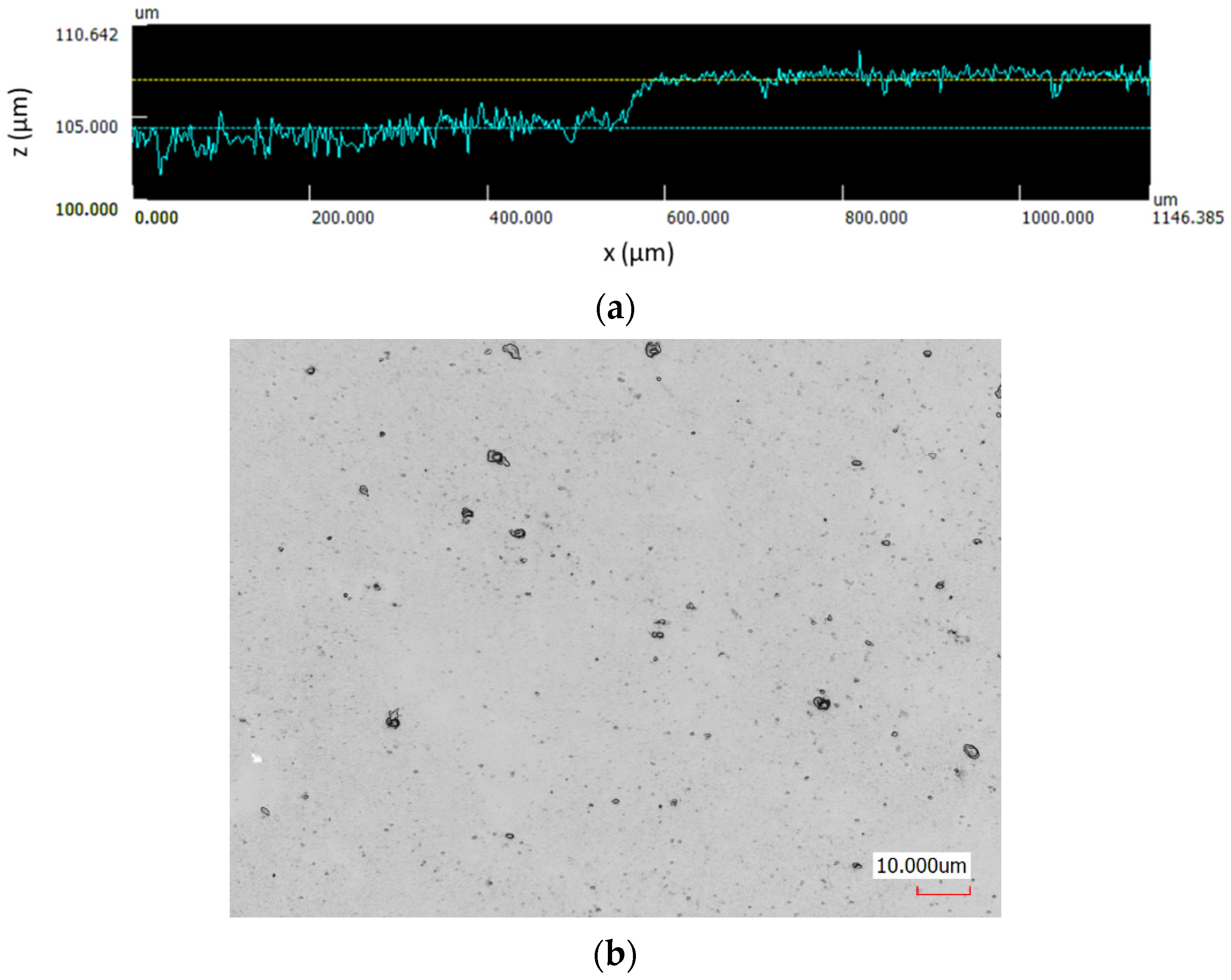

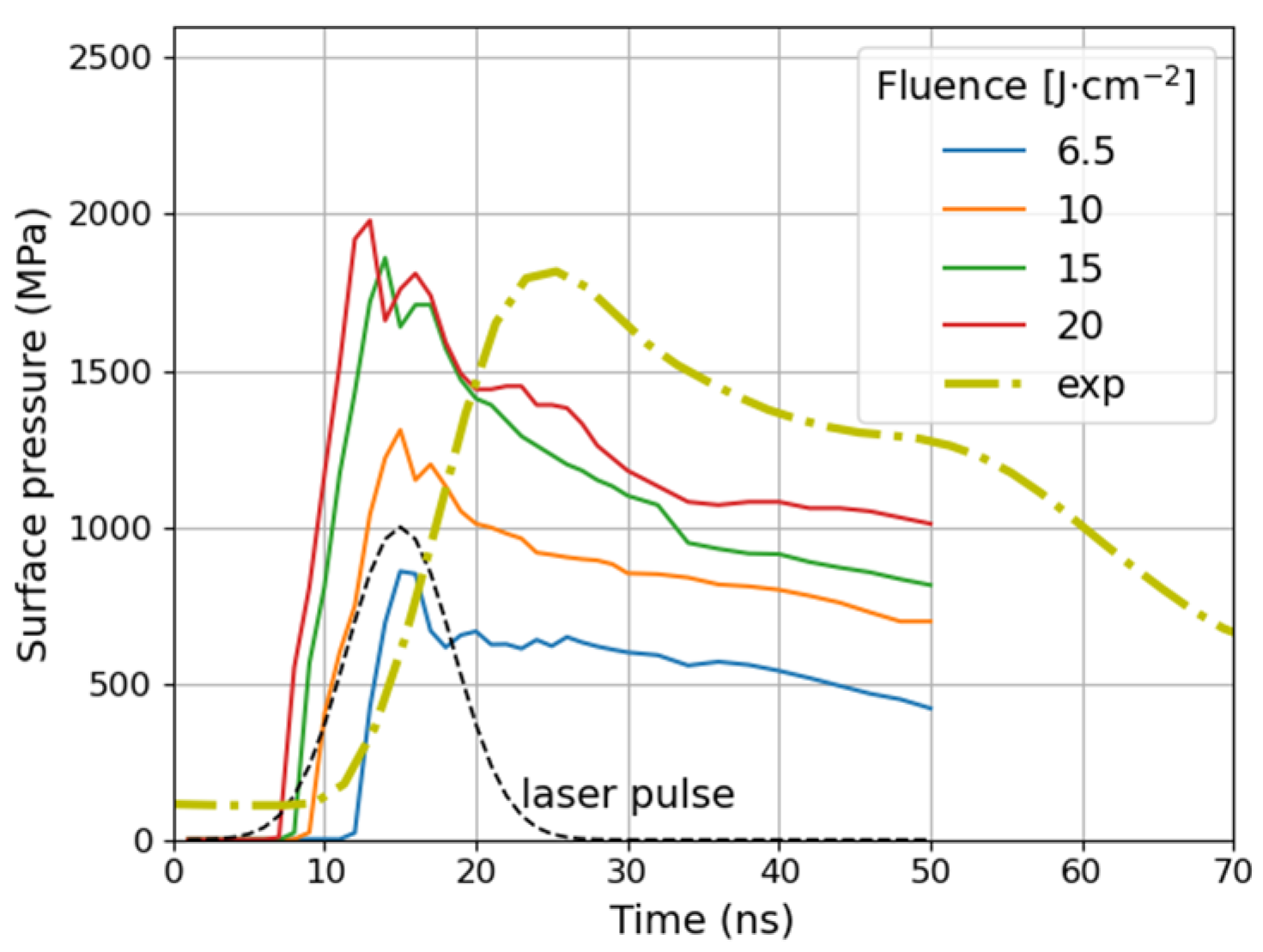
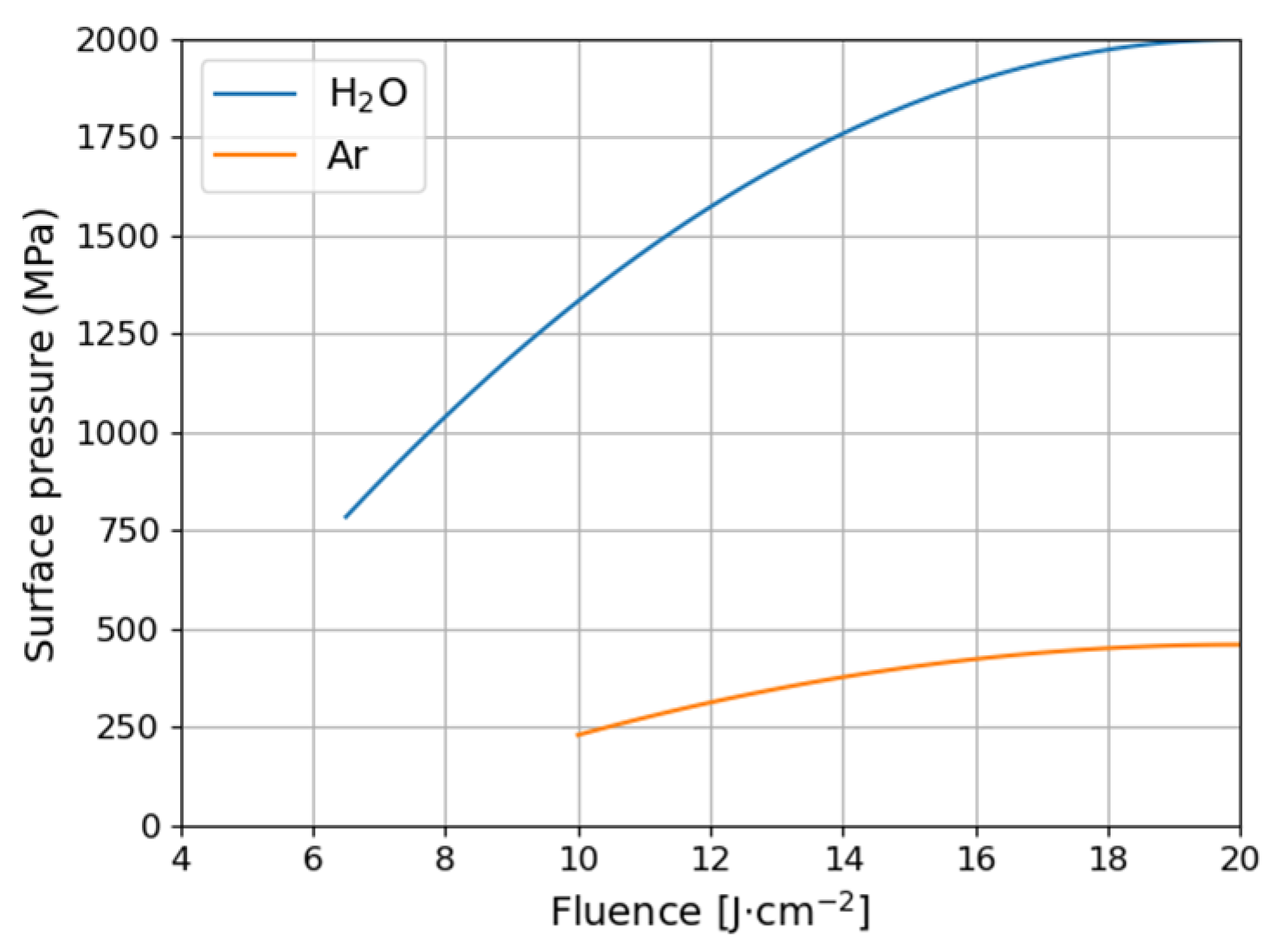
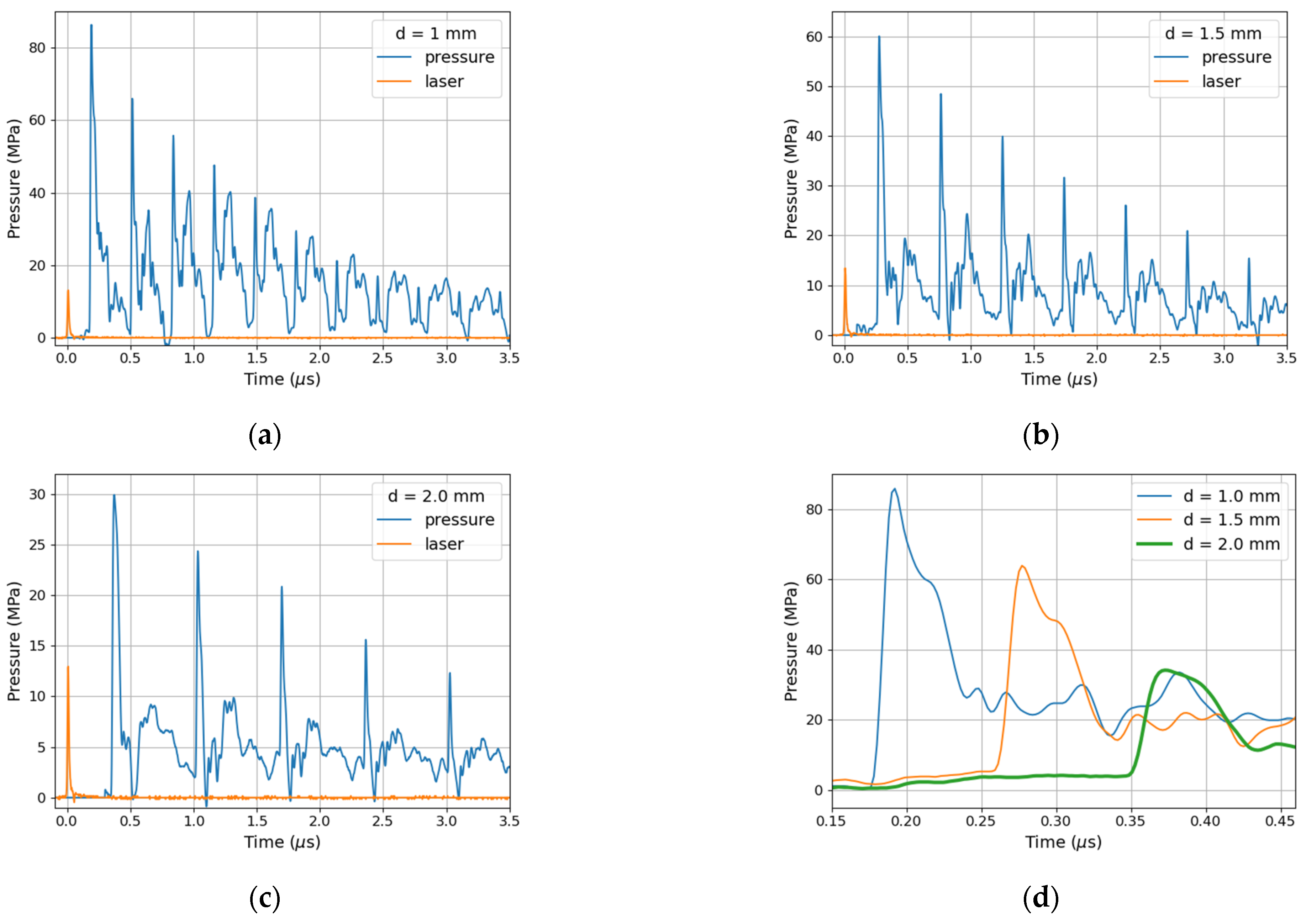
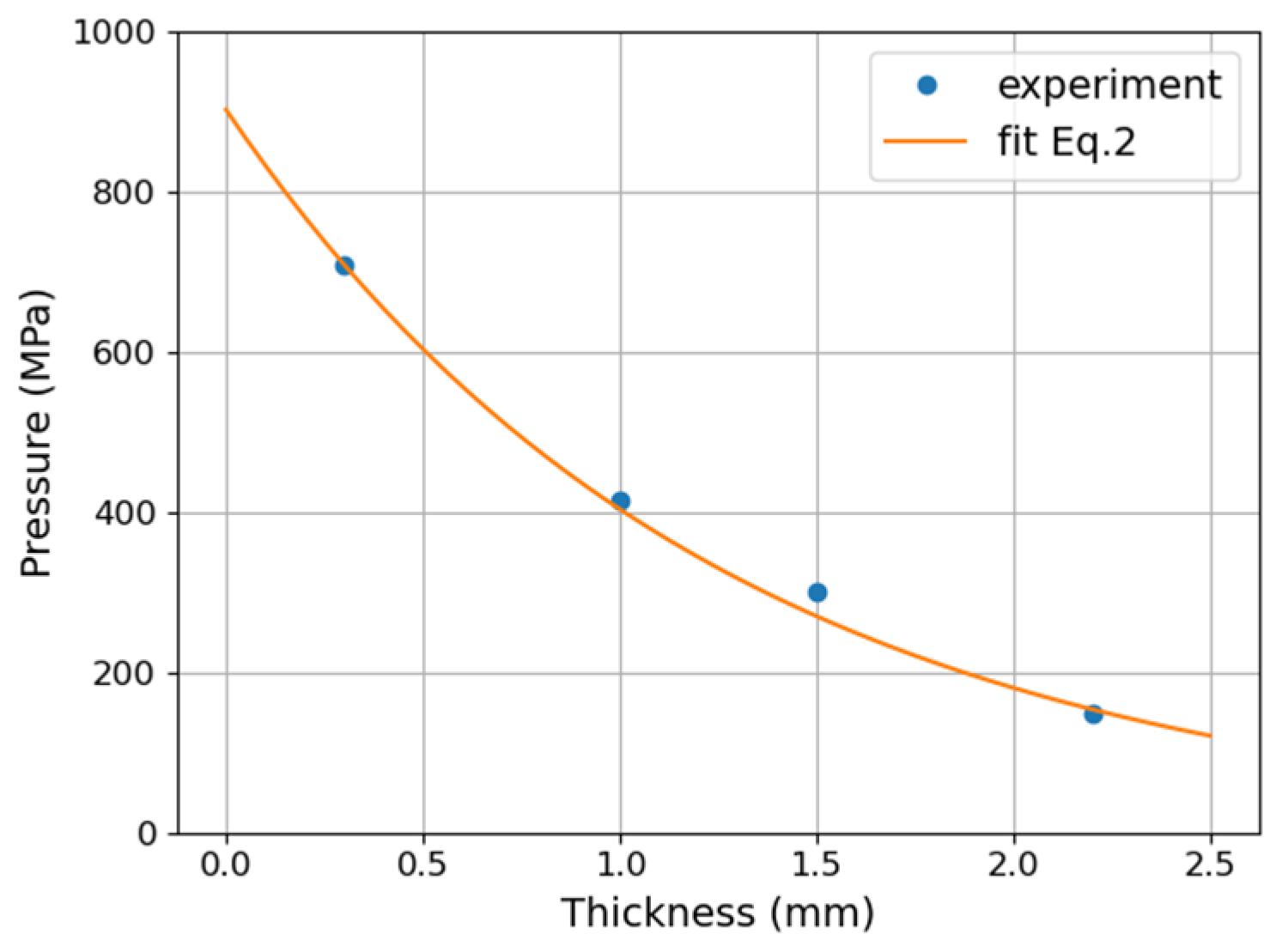
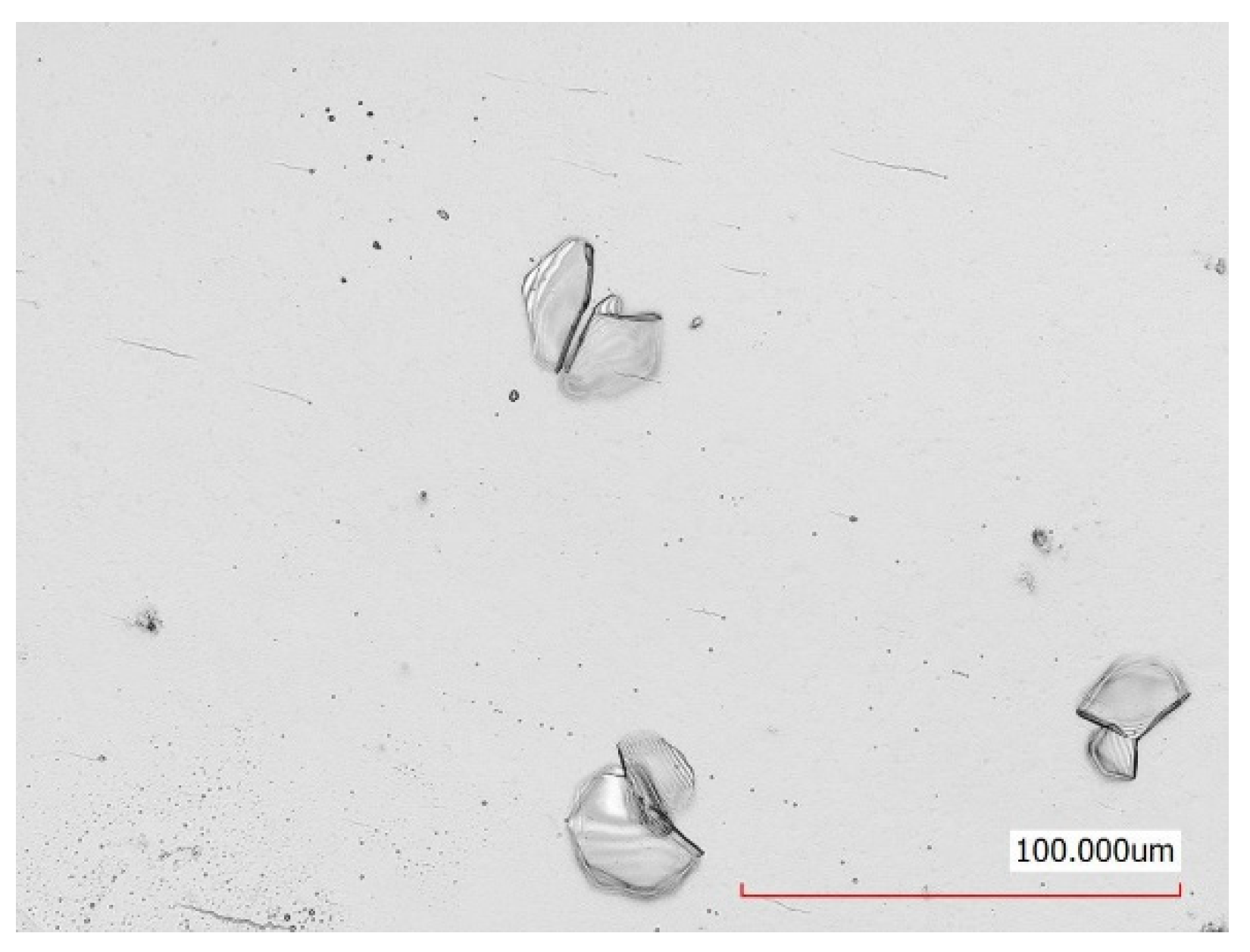
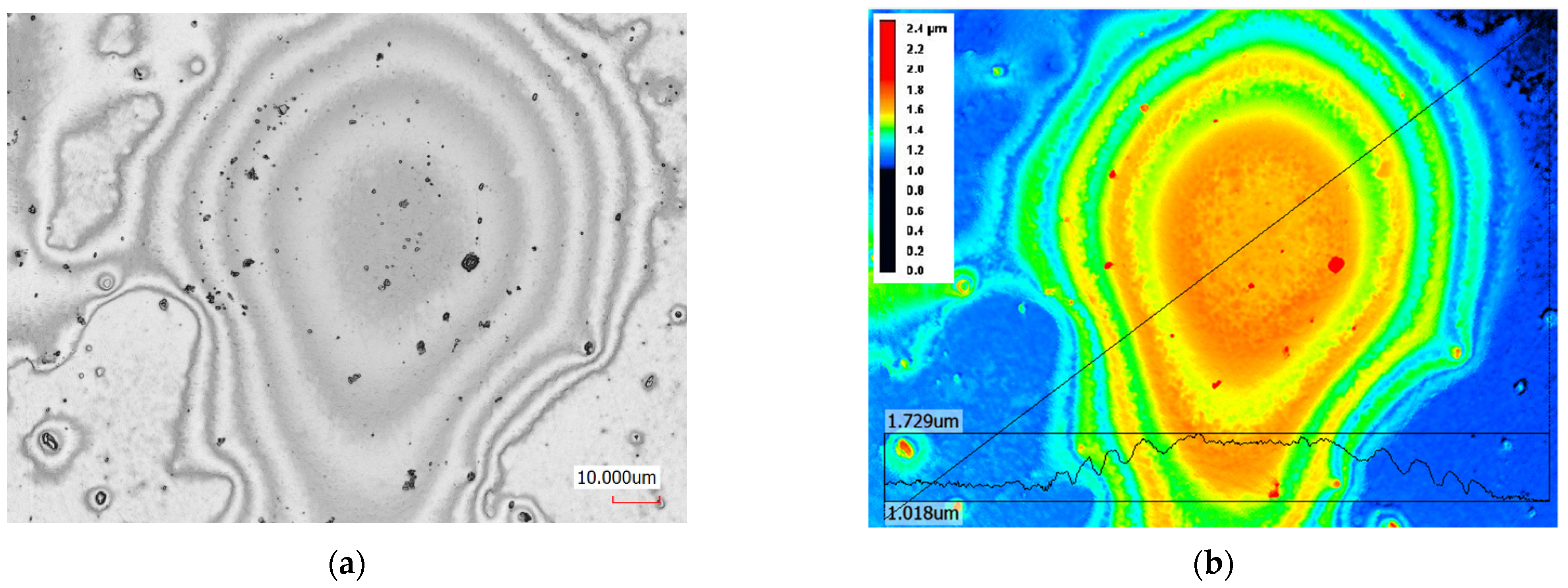
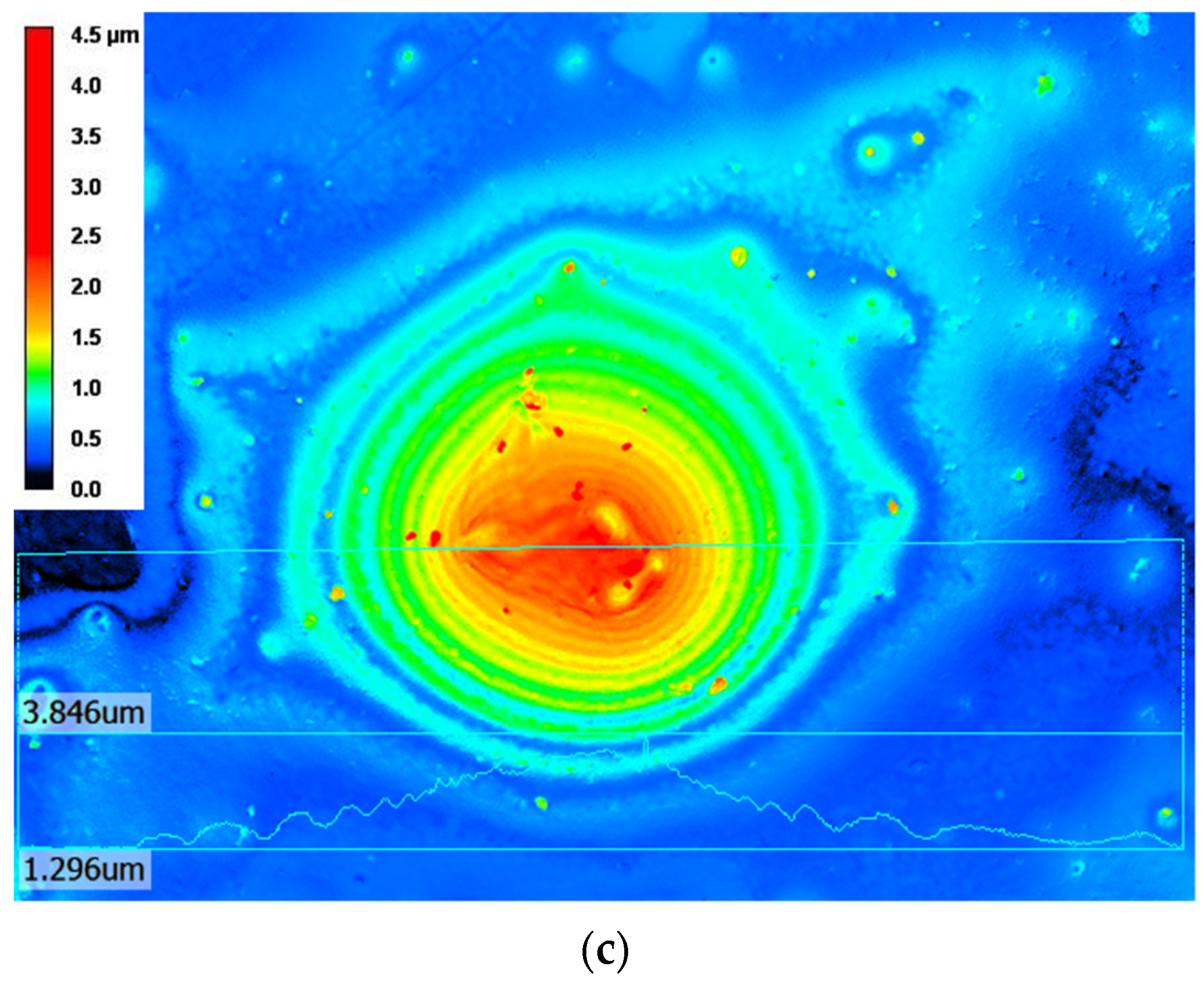
| C | Si | Mn | P | S | Cr | Mo | W | V | Co | Ni |
|---|---|---|---|---|---|---|---|---|---|---|
| 0.86–0.94 | Max. 0.45 | Max. 0.40 | Max. 0.03 | Max. 0.03 | 3.80–4.50 | 4.70–5.20 | 5.90–6.70 | 1.70–2.10 | - | - |
Publisher’s Note: MDPI stays neutral with regard to jurisdictional claims in published maps and institutional affiliations. |
© 2021 by the authors. Licensee MDPI, Basel, Switzerland. This article is an open access article distributed under the terms and conditions of the Creative Commons Attribution (CC BY) license (https://creativecommons.org/licenses/by/4.0/).
Share and Cite
Radziejewska, J.; Kaczmarek, A.; Mościcki, T.; Hoffman, J. Temporal Evolution of Pressure Generated by a Nanosecond Laser Pulse Used for Assessment of Adhesive Strength of the Tungsten–Zirconium–Borides Coatings. Materials 2021, 14, 7111. https://doi.org/10.3390/ma14237111
Radziejewska J, Kaczmarek A, Mościcki T, Hoffman J. Temporal Evolution of Pressure Generated by a Nanosecond Laser Pulse Used for Assessment of Adhesive Strength of the Tungsten–Zirconium–Borides Coatings. Materials. 2021; 14(23):7111. https://doi.org/10.3390/ma14237111
Chicago/Turabian StyleRadziejewska, Joanna, Agata Kaczmarek, Tomasz Mościcki, and Jacek Hoffman. 2021. "Temporal Evolution of Pressure Generated by a Nanosecond Laser Pulse Used for Assessment of Adhesive Strength of the Tungsten–Zirconium–Borides Coatings" Materials 14, no. 23: 7111. https://doi.org/10.3390/ma14237111







